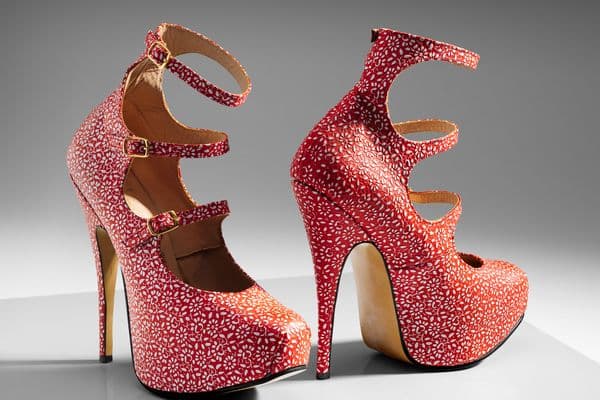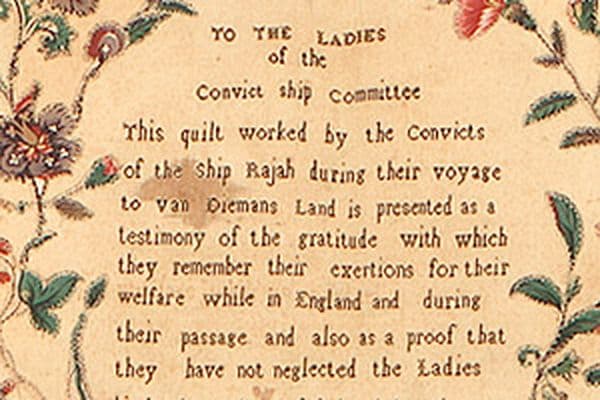A wild world of patchwork: The influence of Japonisme on Western crazy quilt designs

Margaret Weir, Piece of a quilt, c.1910, National Gallery of Australia, Kamberri/Canberra, gift of Alison Brown, the artist's niece, 1982
ALICE REZENDE considers the aesthetic impact of Japonisme, a rich cross-cultural phenomenon of the late nineteenth century that left no stone unturned.
A widely popular style in the second half of the nineteenth century across Europe, North America and Australia, crazy quilts boast an origin story of commerce and cultural fascination. In 1853 a regular trading route between Japan and the West was forcibly re-established by the United States navy into Tokyo harbour.1 What followed were similar treaties demanded by and signed with other countries, including Britain and France and the subsequent establishment of fashionable Japanese import shops in London and Paris.2 A series of international exhibitions both in Europe and North America followed, where the new aesthetic composition of Japanese ceramics, prints, lacquerware, textiles and other decorative arts were greatly admired by Western audiences. These events and exhibitions were pivotal in disseminating Japanese art and culture to broader industrial middle-class audiences.3 Soon, the love for all things Japanese emerged and, with it, the Japonisme phenomenon.
'The forms on the dully gleaming silk surface shine forth from the ornamental pattern. The Japanese decorative sense is anti-axial, single-centred, often delicately florid, or tending towards unity within all-embracing borders: in short, it can cope with the most unusual formats — even clothing.'4
Coined by French critic and collector Philippe Burty in 1872, Japonisme spread widely throughout various arts fields including painting, sculpture, craft, fashion, design, architecture, photography, theatre and music in the second half of the nineteenth century.5 The European decorative arts had found themselves in what Chisaburō Yamada describes as an ‘inspirational stalemate’. They sacrificed ‘beauty of workmanship for the sake of industrial mass-production’, making Japanese culture particularly alluring.6 In broad terms, Japonisme as a movement thus sought to appropriate the essential principles of Japanese art – exemplified by a ‘variety of form, expression … [and] construction’,7 asymmetry (fukinsei) and imperfection (wabi-sabi) – to generate new and unique works. Rather than a matter of simple transference or imitation of techniques and motifs to Western art forms, this influence was a much more complex and dialectic occurrence: a cross-cultural moment in the world of arts and design which resulted in rich and infinitely varying ‘Anglo–Japanese’ styles.8
Crazy quilts are a prime example of this unfolding movement, for a wide range of Japanese arts and design media reverberate through their typical composition and techniques. The characteristic surface cracks or ‘crazed’ glaze of Japanese raku ware is likely to have inspired the name of these quilts, while another type of Japanese ceramics, satsuma ware, featuring highly decorative motifs — such as coloured flowers and animals and figures — trimmed with gold, is stylistically resonant.9 International exhibition showcases of embroidered Japanese silk screens with kindred designs of ‘scenes in the daily life of the people’10 and the rendering of decorative textiles within the brightly coloured pictorial scene of ukiyo-e blocks, likewise would have made a memorable impression in the collective consciousness of European painters and craftspeople. While these clues are strong confirmations of the historical and social significance of quilting as an art form within the canon of the decorative arts, quilting was not viewed as an art form so much as a domestic hobby. This seems most perplexing given the concurrent development of the Aesthetic Movement (1860–1900) in Britain, which pushed for a blurring of the boundaries between the ‘fine’ and the decorative (‘low’) arts and the elevation of craftspeople.

Asakura Kuniyoshi, Ichiyusai Kuniyoshi, Kaito Maru Karasuboshiki-no-zu, National Diet Library Digital Collections, public domain
Although the recognition of quilting as an artistic practice did not come until much later, it is possible to observe how Japanese aesthetic principles and techniques embraced by ‘real artists’ were also being readily absorbed by quilters — even those living in far-flung Australia — whether they saw themselves as artists or not. Margaret Weir (1856–1934), the maker of Piece of quilt c 1910, considered herself as an artist, albeit in reference to her painting work. As an art student at the National Gallery of Victoria School between 1890 and 1891,11 Weir would have had access to artists’ instruction manuals, which were published in large editions and imported from Europe. Many of these manuals detailed Japanese principles of compositional organisation, including the aesthetics of diagonal and mosaic-like compositions, silhouetting and grid patterns and cut-off objects placed in the foreground.12
'The Japanese … are instinctive decorators, though in a less formal and more impressionistic way, and with much more naturalistic feeling. Their pictures printed from colour blocks, as well as their "kakimonos," painted on silk, are frankly pattern-pictures, the pattern motive being quite as strong or stronger than the graphic or representative motive.'13
In Weir’s quilt there is deliberate intent in the application of leaves and petals as patterning motifs. At the same time, the colour-tinted effect of these objets trouvés, or found objects, is almost painterly. The combination of varied and intricate laces, satins, silk velvets and printed ikats — the latter emulating the watercolour-like effect of the rose-tinted petals — creates a highly textured yet delicate surface. Weir deliberately refrained from using strongly contrasting fabrics, a key design feature in most typical crazy quilts designs, resulting in a cream surface akin to porcelain splashed with watered-down rose, pink and orange accents. While Weir may not have consciously viewed this piece as a work of art, she certainly seems to have merged Japanese aesthetic principles learned through her own painting practice.

Margaret Weir, Piece of a quilt, c.1910, crazy quilt style: silk velvet, lace, printed ikat, satin and plain weave, silk and cotton thread; hand embroidered, hand stitched, National Gallery of Australia, Kamberri/Canberra, gift of Alison Brown, the artist's niece, 1982.
Nineteenth-century women who did not attend art school were not immune from the influence of Japanese culture across almost all facets of Victorian life. Many middle-class Australian settler women had access to domestic manuals and women’s magazines which published crazy patchwork and embroidery patterns. Although at face value these patterns might be deemed as trickle-down references to Japanese art and design objects, their use did not diminish the quilter’s inventiveness. A stunning example is the Quilt c 1890 made by Scottish-born Christina Brown (1915–1895). Arriving in Australia in 1842, Brown lived on Wiradjuri Country/Bowenfels, New South Wales, with her husband Andrew and their three children. Her quilt combines over 167 irregularly shaped patches, reflecting a predilection for ‘contrasts … of masses … perfect balances and harmonies of unequal parts, and broken up surfaces’,14 as well as motifs such as sunflowers and butterflies, all typical of Japanese design aesthetics of the time.15

Christina Brown, Quilt, c.1890, crazy quilt style: silk and cotton velvet, satin, brocade, tartan and grosgrain, silk and cotton thread; hand appliquéd, hand and machine embroidered, hand and machine stitched, National Gallery of Australia, Kamberri/Canberra, purchased 1989.
Though Brown mostly used geometric patches for the background, in the foreground she chose to stitch large crest-like circles embroidered with prominent flowers. These round patches not only resemble decorative Japanese plates or fans but seem to also allude to Japanese mons, traditional emblems used to identify an individual or family. This is significant when considering the prominence of various initials embroidered in the quilt — which likely reference Christina’s husband (‘AB’) and children — as well as distinct small blue flowers embroidered throughout. A kind of wholly local Australian mon, it has been suggested16 the flowers were abundant in the region and also the namesake of Brown’s land estate, Cooerwull, meaning ‘small blue flower growing there’ in Wiradjuri language.17

E. W. Godwin (designer), Warner and Sons (maker), Butterfly Brocade 1874–76 (detail), Victoria and Albert Museum collection, London, © Victoria and Albert Museum. The Butterfly Brocade is a well-known example of a developed ‘Anglo–Japanese’ style for interior furnishings. It also bears direct influence from Japanese mon family crests.
Meanwhile, in Constance (c 1812–c 1915) and May (c 1813–c 1915) Bright’s Quilt 1893, the all-over design focus is on the textural variety and contrast of fabrics. This too, is indicative of a strong Japanese influence, though again, likely conceived through exposure to women’s literature on embroidery and quilt patterns. That of course should not undermine the originality or creativity of the English-born Bright sisters, but rather situate the predilection for brightly coloured and mosaic-like ungeometric designs so favoured at the time. As Rutherford Alcock remarks in the widely distributed Art and Art Industries in Japan (1878):
'The Japanese possess … the instinct of colour … they are perfect masters of the law of contrast … Part of this secret is in the arrangement of pattern as well as colour. The strong design will often be broken off with a jagged edge, gently to break, as it were, the moment of change from one colour to the other. Another favourite form of decoration is to print a pattern on crape of soft silk, and afterwards to embroider the prominent objects. Thus we see a stamped design of bamboo, the stems and leaves printed, and the flowers or berries embroidered in silk and gold.'18
Set against an olive sateen frame, each of the nine panel compositions in the Bright sisters’ quilt features the textural contrast of at least one silk velvet patch in either navy, blue, plum or wine and one reflective fabric such as taffeta or brocade. Like the decorative example in crape or silk noted by Alcock, here natural motifs such as flowering shrubs and butterflies are tied together by gold trim — thread in this case — that alternates between round couching stitches and angular zigzags.

Constance Bright, May Bright, Quilt, 1893, crazy quilt style: silk velvet, taffeta, brocade, tartan, grosgrain ribbon, cotton velvet, cotton sateen (lining and edging), cotton (inner), cotton and metallic thread; hand appliquéd, hand embroidered, hand and machine stitched. National Gallery of Australia collection, Kamberri/Canberra collection, gift of Jean Brodie 1998.
The popularity of crazy quilting in the second half of the nineteenth century points to a widening of the Western aesthetic consciousness which would become crucial for the spurring of the modernist project some years later. Much like influential painters such as James Whistler, Vincent van Gogh and Gustav Klimt, these quilters were open to new artistic principles and forms through which to express their world. The Japanese compositional techniques embraced by artists and craftspeople alike at the time can be summed up as a ‘systematic irregularity’19 which was ultimately deeply alluring. The sensibility demonstrated by these quilters in synthesising elements from the far East and West is exceptional and enables us to admire them not only for their beauty but their rich cross-cultural value.
A Century of Quilts is on display from 16 March – 25 August 2024.
Yuuma, Gurruburri
The National Gallery acknowledges the Ngunnawal
and Ngambri peoples, the Traditional Custodians of
the Kamberri/Canberra region, and recognises their
continuous connection to culture, community and
Country.









///national-gallery-of-australia/media/dd/images/85677_-_StC_Preview_JPG_2000px.jpg)


